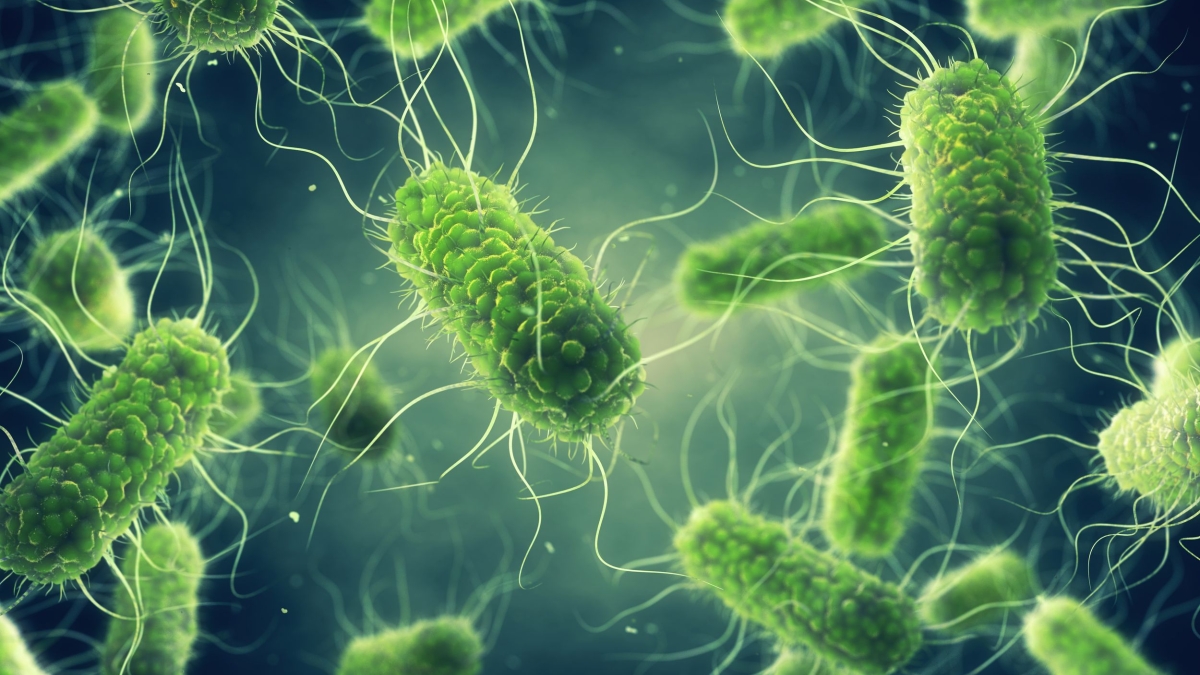New study explores role of key protein in regulating infection by salmonella

Salmonella bacteria invade human intestinal epithelial cells. The pathogen, explored in a new study, is the leading cause of food-borne illness.
Infectious diseases continue to ravage human society and remain a leading cause of illness and death worldwide. Improving therapies to treat these afflictions will require a better understanding of the intricate dance between infectious pathogens and the human cells they infect.
In new research appearing in the journal mSphere, Arizona State University researcher Cheryl Nickerson, her former graduate student Karla Franco Meléndez and colleagues explore an understudied aspect of the infection process — the physical forces acting on invasive bacterial cells during infection inside the body — which can trigger profound alterations in the behavior of pathogens and alter disease progression.
To explore the effects of these mechanophysical forces on host and pathogen cells, the researchers investigated an important bacterial cell regulator known as RpoS.
The role of this protein is to enhance cell survival, protecting the bacterium from a variety of harmful conditions and stresses encountered in the infected host, as well as in the environment.
The target organism of study is the intestinal bacterium salmonella, a prolific pathogen and a leading cause of bacterial food-borne illness worldwide.
The researchers relied on an innovative approach, which more accurately mimics the physical forces impacting bacterial cells during infection inside the host, as opposed to growing bacteria under traditional laboratory conditions using shaking flasks or static cultures. By culturing the bacterial pathogen salmonella in a device known as a rotating wall vessel bioreactor, the researchers subjected the cells to physical forces similar to those encountered when salmonella infects epithelial cells in the human intestine.
Specifically, the gentle tumbling of cells within the device modulates a condition known as fluid shear, which refers to the abrasive forces of extracellular fluids on cell surfaces. Previous research has established that low fluid shear forces (LFS) typically encountered by pathogens during infection can profoundly affect bacterial gene expression, invasive capacity into tissues and virulence (disease-causing ability), and can alter resistance to various cellular stresses.
These fluid shear-induced changes in salmonella cell behavior were first observed during the so-called log phase of bacterial growth, a period of exponential bacterial cell proliferation. The new study explores, for the first time, the effects of low fluid shear and RpoS activity on the ability of salmonella to both colonize human intestinal cells and resist killing by a range of different stressors during their stationary phase, which typically occurs before salmonella are ingested or when the bacteria lack essential nutrients or face acute stress from changes in pH, temperature and other variables encountered in the infected host.
The study results demonstrated that the master regulator RpoS operates differently during the stationary phase when salmonella are cultured under physiological LFS conditions compared with traditional culturing, in which the cells are held in a static state or shaken in a flask.
Cheryl Nickerson
Nickerson is a researcher in the Biodesign Center for Fundamental and Applied Microbiomics and professor in the School of Life Sciences at ASU. Her team’s pioneering work has advanced our understanding of the impact of physical forces on microbial pathogens and infectious disease outcomes, which helped lay the foundation for the rapidly emerging field of the mechanobiology of infectious disease.
“This work builds upon my team’s long-standing interest in how physical forces encountered by microbial pathogens in the infected host impact their disease-causing potential, and the underlying mechanisms responsible for their pathogenesis under these conditions,” Nickerson says. “Findings from this paper add to our mechanistic studies focused on a complete understanding of the regulation of salmonella pathogenesis by physiological fluid flow, the results of which are important in predictive disease modeling and for development of new antimicrobial treatments.”
Pervasive pathogen
The intestinal bacterium salmonella has an ancient pedigree. Traces of the pathogen have been detected in human skeletal remains dating to over 6,500 years ago. The salmonella genus however, likely emerged some 120 to 160 million years ago. It has evolved into over 2,300 genetically and phenotypically diverse forms, known as serovars. Among these is S. Typhimurium, target of the current research.
Salmonella bacteria cause about 1.35 million infections, 26,500 hospitalizations and 420 deaths in the United States every year, according to the CDC. Most of these illnesses are linked with contaminated food or water.
Symptoms of infection with S. Typhimurium typically begin six hours to six days after infection and include diarrhea, fever and stomach cramps. The illness usually lasts four to seven days, and while the ailment can be acutely unpleasant, most recover without treatment. Patients who are immunocompromised run the risk of more severe symptoms, and in some cases, hospitalization may be required.
A curse for patients, a boon to science
S. Typhimurium has historically been among the most useful model organisms for the study of host-pathogen interactions and infectious disease mechanisms. Exploring this pathogen in detail demonstrated for the first time that physical forces acting on bacterial cell surfaces can regulate microbial virulence, a discovery made by Nickerson’s team over 20 years ago.
This early research established that low fluid shear forces, comparable to those encountered by salmonella during invasion of the intestinal tract, increased virulence and overall stress resistance, and differentially regulated gene expression during the bacterium’s logarithmic phase of explosive growth. This log phase response occurred independently of the RpoS regulator under low fluid shear conditions.
The new study extends the team’s earlier findings, but this time focuses on the role of RpoS in regulating responses during the pathogen’s stationary phase under low fluid shear force conditions, an underexplored area of research. Stationary phase is a common growth condition that bacteria experience when they have exhausted their nutrients and which enhances their general stress resistance.
Salmonella can experience the stationary phase condition in the environment (e.g., in foods or on surfaces) prior to ingestion, as well as in the body during infection (e.g., colonization of intestinal epithelial cells). RpoS is considered to be the master stress response regulator in stationary phase.
Trajectory through the digestive tract: a stressful existence
Salmonella’s prolific success as a pathogen is due in part to its impressive ability to endure several sources of stress. In the human body, stomach acids and intestinal bile salts can be lethal to invasive pathogens, but salmonella has evolved sophisticated mechanisms to cope with such threats.
Other hazards to salmonella survival include thermal stress, particularly during the process of cooking foods on which the bacteria may lurk, as well as oxidative stress, caused by reactive oxygen species within the host.
In the current study, salmonella were grown in stationary phase using the rotating wall vessel bioreactor to approximate low fluid shear conditions found in the intestine during normal infection. The researchers compared wild type salmonella containing the RpoS regulator with an RpoS-free mutant strain. The aim was to evaluate the responses of salmonella bacteria exposed to the kinds of stresses they typically encounter while infecting human cells in the body.
The study establishes for the first time that low fluid shear-induced resistance to both acid and bile salts stress in Salmonella during stationary phase is not dependent on the RpoS regulator. These results were unexpected, as RpoS is required for salmonella stationary phase resistance to these same stressors when the bacteria are cultured under conventional laboratory conditions, which fail to reproduce physiologically relevant fluid shear forces.
In the case of thermal or oxidative stress however, the RpoS regulator did exert an effect on stress resistance in stationary phase cultures under low fluid shear conditions, resulting in different stress responses in salmonella cells containing a functional RpoS protein compared with a mutant strain engineered to lack the RpoS regulator.
The work deepens the understanding of the Salmonella infection process, paving the way for improved treatments for a broad range of infectious diseases.
Reaching the site of infection
Karla Franco Meléndez
Next, the two salmonella strains, with and without the RpoS regulator, were used to colonize human colonic epithelial cells cultured in the laboratory and the results compared. During early colonization of epithelial cells, salmonella must pass through a series of checkpoints, successfully attaching to host cells, invading them and surviving within.
The data specifically addressed potential differences in cell adherence, invasion and intracellular survival, critical variables in the infection process that RpoS has been shown to regulate when Salmonella enterica pathovars are grown to stationary phase under conventional laboratory conditions.
Under the low fluid shear culture conditions in this study, both S. Typhimurium strains displayed a significantly enhanced capacity for cell adhesion and survival within human intestinal epithelial cells, suggesting that these infections events did not require a functional RpoS protein. These findings are different from those observed during traditional laboratory culture of this pathogen, where RpoS mediates these same responses in stationary phase Salmonella. On the contrary, invasion of these host cells were dependent on RpoS.
“Although S. Typhimurium is one of the best characterized microbial pathogens, little is known about how physical forces regulate its pathogenicity in the context of host-microbe interactions,” Meléndez says. “Our results emphasize the importance of including relevant fluid shear forces when trying to understand how salmonella mounts a response to stressors encountered during their digestive tract journey. We also observed an unexpected relationship between the fluid shear response and RpoS in regulating S. Typhimurium phenotypes.”
The research deepens the understanding of salmonella infection processes under physically relevant conditions of low fluid shear and highlights the importance of duplicating cell environments experienced by pathogens within the infected host. Future work in this area may pave the way for the development of new therapies for treating salmonella infection and better managing a broad range of infectious pathogens.
More Science and technology

Diagnosing data corruption
You are in your doctor’s office for your annual physical and you notice the change. This year, your doctor no longer has your…
Large-scale study reveals true impact of ASU VR lab on science education
Students at Arizona State University love the Dreamscape Learn virtual reality biology experiences, and the intense engagement it…

ASU-led space telescope is ready to fly
The Star Planet Activity Research CubeSat, or SPARCS, a small space telescope that will monitor the flares and sunspot activity…



